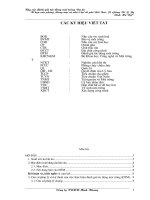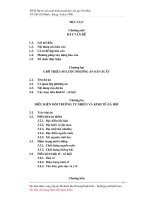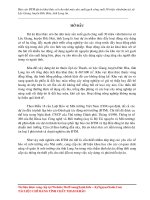tư liệu đánh giá tác động tôi học kinh tế
Bạn đang xem bản rút gọn của tài liệu. Xem và tải ngay bản đầy đủ của tài liệu tại đây (41.01 KB, 10 trang )
<span class='text_page_counter'>(1)</span><div class='page_container' data-page=1>
SISERA TRAINING WORKSHOP
ON POVERTY DYNAMICS
The Shapley Value
By
Araar Abdelkrim
</div>
<span class='text_page_counter'>(2)</span><div class='page_container' data-page=2>
<b>THE SHAPLEY APPROACH</b>
The Shapley value is a solution concept often employed in the theory of cooperative games. We
consider a set N, constituted of n players that must divide a given surplus among themselves. The
players group themselves together to form coalitions (these are the subsets S of N) that
appropriate themselves a part of the surplus and redistribute it between their members. We
suppose that the function v determines the coalition force, i.e., which surplus will be divided
without resorting to an agreement with the other players (that are members of the complementary
coalition “(n-s-1) players”). The question to resolve is the following one: how can we divide the
surplus between the n players? According to the Shapley approach, introduced by Lloyd Shapley
in 1953, the value of the player k in the game, given by the characteristic function v, is given by
the following formula:
{
}
∑ − −
=
−
∈⊂0,n 1
s
S
s
k MV(S,k)
!
n
)!
1
s
n
(
!
s
C <b> </b>And<b> </b>MV(S,k)=
(
v(
S∪{ }
k)
−v(S))
<b><sub>(01) </sub></b><b>EXPLANATION AND INTERPRETATION OF THE SHAPLEY VALUE</b>
The term, MV (S, k) is equal to the marginal value that the player k generates after his adhesion
to the coalition S. What will then be the expected marginal contribution of player k, according to
the different possible coalitions that can be formed and to which the player can adhere? First of
all, the size of the coalition S is limited such as: s∈
{
0,1,...n−1}
. Suppose that the n players arerandomly ordered according to an order, noted byσ, such as:
σ
σ
σ
σ
σ
σ
=
σ
−
−
+
− <sub>1</sub><sub>42</sub><sub>4</sub>L<sub>43</sub><sub>4</sub>
4
4 3
4
4 2
1 L
1
s
n
n
1
k
k
s
1
k
2
1, , , , , , ,
<b>(02) </b>
For each of the possible permutations of the n players, which number n!, the number of times that
the same first s players are located in the subset or coalition S is given by the number of possible
permutation of the s players in coalition S, that is, s!.
For every permutation in the coalition S, we find (n-s-1)! permutations for the players that
complement the coalition S.
The expected marginal value that player k generates after his adhesion to a coalition S is given by
the Shapley value, as indicated in equation (01).
For every position of the factor k (predetermined cuts of the coalition S), there are several
possibilities to form coalitions S from the n-1 player (the n players without the player k). This
number of possibilities is equal to the combinationCs<sub>n</sub><sub>−</sub><sub>1</sub>.
</div>
<span class='text_page_counter'>(3)</span><div class='page_container' data-page=3>
Because the order of the players in the coalition S does not affect the contribution of the player k
once he has adhered to the coalition, the number of calculations needed for the marginal values is
reduced from n! to ∑
−
= −
1
n
0
s
s
1
n
C = 2n-1 (see annex A).
<b>Remark: </b>
When the marginal contribution of the factor k, MV(S, k) is same whatever be the order or the
coalition S, the Shapley value for the factor k will then be given by this that follows:
{
}
∑ − −
=
−
∈⊂0,n 1
s
S
s
k x
!
n
)!
1
s
n
(
!
s
C <b><sub>(03) </sub></b>
(
)
n! x x)!
1
s
n
(
!
ns
!
s
n
!
s
!
n
x
!
n
)!
1
s
n
(
!
s
C
C n 1
0
s
s
1
n
k ∑ =
−
−
−
=
−
−
= −
=
− <b>(04)</b>
</div>
<span class='text_page_counter'>(4)</span><div class='page_container' data-page=4>
<b>ILLUSTRATION OF THE SHAPLEY VALUE WITH TWO FACTORS (2 PLAYERS)</b>
Suppose an index I that depends on two factors A and B. The decomposition of this index
consists in calculating the expected marginal contribution of every factor.
<b>Number of permutations = </b>n!=2!=2
<b>Permutations </b> <b>Marginal contribution of factor A </b>
<b>1 </b>
<sub>{ }</sub>
B
,
A
1 <sub>=</sub>
σ
{ } { }
/
/
=
φ
=
A
,
B
S
{ } { }
A AS∪ =
0
s=
{ }
(
)
(
v
S
∪
k
−
v
(
S
)
)
=
I(A)
-
0
In this first case, one looks for
the marginal contribution of the
added factor A to a set of
factors that is empty.
<b> 2 </b>
{ }
A
,
B
2
<sub>=</sub>
σ
{ } { }
B,A BS= / =
{ } { }
A
B
,
A
S
∪
=
1
s=
{ }
(
)
(
vS∪ k −v(S))
=I(A,B)-I(B)Here, the set of factors
(coalition) that already exist is
the factor B.
<b>Concordances with the Shapley formula: </b>
Possible coalitions
for the factor A
S <sub>C</sub><sub>=</sub><sub>N</sub><sub>−</sub>
(
<sub>S</sub><sub>∪</sub>{ }
<sub>A</sub>)
Weight attributed to thefactor A according to the
case
<b>Case 1 </b>
<sub>S</sub>
=
{ }
φ
<sub>,</sub>
<sub>s</sub>
=
<sub>0</sub>
<sub>C</sub>
=
{ }
<sub>B</sub>
<sub>,</sub>
<sub>n</sub>
−
<sub>s</sub>
−
<sub>1</sub>
=
<sub>1</sub>
<sub>s</sub>
<sub>!</sub>
(
<sub>n</sub>
−
<sub>s</sub>
−
<sub>1</sub>
)
<sub>!</sub>
<sub>/</sub>
<sub>n</sub>
<sub>!</sub>
=
<sub>1</sub>
<sub>/</sub>
<sub>2</sub>
<b>Case 2 </b> <sub>S</sub><sub>=</sub>
{ }
<sub>B</sub><sub>,</sub><sub>s</sub><sub>=</sub><sub>1</sub> <sub>C</sub><sub>=</sub>{ }
<sub>φ</sub><sub>,</sub><sub>n</sub><sub>−</sub><sub>s</sub><sub>−</sub><sub>1</sub><sub>=</sub><sub>0</sub> <sub>s</sub><sub>!</sub>(
<sub>n</sub><sub>−</sub><sub>s</sub><sub>−</sub><sub>1</sub>)
<sub>!</sub><sub>/</sub><sub>n</sub><sub>!</sub><sub>=</sub><sub>1</sub><sub>/</sub><sub>2</sub>(
)
[
I(A,B) I(B) I(A)]
2
1
)
B
(
I
)
B
,
A
(
I
2
1
)
A
(
I
2
1
CA = + − = − + <b>(05) </b>
(
)
[
I(A,B) I(A) I(B)]
2
1
)
A
(
I
)
B
,
A
(
I
2
1
)
B
(
I
2
1
</div>
<span class='text_page_counter'>(5)</span><div class='page_container' data-page=5>
<b>ILLUSTRATION OF THE SHAPLEY VALUE WITCH THREE FACTORS (3PLAYERS) </b>
Suppose an index I that depends on three factors A, B and C. The decomposition of this index
consists to calculate the expected marginal contribution of every factor.
<b>Number of permutation = </b>n!=3!=6
<b>case </b> <b>Permutation </b> <b>Size of </b>
<b>coalition S </b>
<b>Marginal contribution of factor A </b>
<b>1 </b>
<sub>{</sub>
<sub>}</sub>
C
,
B
,
A
1<sub>=</sub>
σ s=0 I(A)-0
<b>2 </b>
<sub>{</sub>
<sub>}</sub>
B
,
C
,
A
2 <sub>=</sub>
σ s=0 I(A)-0
<b>3 </b>
<sub>{</sub>
<sub>}</sub>
C
,
A
,
B
3 <sub>=</sub>
σ s=1 I(B,A)-I(B)
<b>4 </b>
<sub>{</sub>
<sub>}</sub>
A
,
C
,
B
4 <sub>=</sub>
σ s=2 I(B,C,A)-I(B,C)
<b>5 </b>
<sub>{</sub>
<sub>}</sub>
B
,
A
,
C
5 <sub>=</sub>
σ s=1 I(C,A)-I(C)
<b>6 </b>
{
}
A
,
B
,
C
6
<sub>=</sub>
σ
s=2 I(C,B,A)-I(C,B)If we note the marginal variation, that results from the elimination of the factor k for the sequence
I, by:
VI
( )
σ
i,
k
(example:VI
( )
σ
1,
A
=
I
(
A
)
−
I
(
φ
)
), the expected marginal contribution offactor k, according the Shapley approach is given by the following equation :
∑ σ
=
=
!
n
1
i
i
k VI( ,k)
!
n
1
C <b>(07) </b>
<b>Concordances with the Shapley formula: </b>
Possible coalitions for the factor A <b>S </b> <b>N-S-{A} </b> Weight attributed to the
marginal contribution
according to the case
Cases 1 and 2
{ }
<sub>φ</sub>0
s=
{ }
B,C2
1
s
n− − =
(
n s 1)
!/n! 2/6!
s − − =
Case 3
{ }
<sub>B</sub>
1
s=
{ }
C
1
1
s
n− − =
(
n
s
1
)
!
/
n
!
1
/
6
!
s
−
−
=
Cases 4 and 6
{ }
<sub>B</sub><sub>,</sub><sub>C</sub>2
s
=
{ }
φ0
1
s
n
−
−
=
(
n s 1)
!/n! 2/6!
s − − =
Case 5
{ }
<sub>C</sub>1
s
=
{ }
B1
1
s
n
−
−
=
(
n s 1)
!/n! 1/6!
s − − =
{
}
∑ − −
=
−
∈⊂0,n 1
s
S
s
k MV(S,k)
</div>
<span class='text_page_counter'>(6)</span><div class='page_container' data-page=6>
<i>Geometrical illustration of the Shapley value</i>
<i><b>Euclidian example </b></i>
An easy example of an index whose values depend on the interaction between the two
components (CX, CY) is the surface of rectangle:
t
Y
t
X
S(t) C *C
I =
In period t1, IS=A and in period t2, IS=A+B+C+D
Suppose that the index VIS indicates the variation in the index IS such us:
)
1
t
(
I
)
2
t
(
I
)
2
t
,
1
t
(
VI<sub>S</sub> = <sub>S</sub> − <sub>S</sub>
<b>Q1: </b> If the period t1 is the reference period, decompose the index of variation VIS, such as:
residue
The
Y
of
on
Contributi
X
of
on
Contributi
)
2
t
,
1
t
(
VI<sub>S</sub> = + +
Answer: VIS= C + B +D
<b>Q2: </b> Do the same decomposition of Q1 when the period t2 is the reference period.
Answer: VIS= (C+D) + (B +D)+(-D)
<b>B </b>
<b>D </b>
<b>Residue </b>
<b>A </b>
<b>C </b>
<b>Component X t1 t2 </b>
</div>
<span class='text_page_counter'>(7)</span><div class='page_container' data-page=7>
<b>Q3: </b> By observing this rectangle, in what cases the residue can be important?
Answer: When the ratio of variation of two components, ∆X/∆Y or its inverse is higher.
<b>B </b>
<b>D </b>
<b>Residue </b>
<b>A </b>
<b>C </b>
<b>Component X t1 t2 </b>
<b> Comp</b>
</div>
<span class='text_page_counter'>(8)</span><div class='page_container' data-page=8>
<b>Q4: </b> By using the Shapley approach, propose an exact decomposition of the index of variation of
the surface of rectangle VIS.
[
] [
]
(
I(C ,C ) I(C ,C ) I(C ,C ) I(C ,C ))
2
1
X
of
on
Contributi = <sub>X</sub>t2 <sub>Y</sub>t1 − <sub>X</sub>t1 t<sub>Y</sub>1 + <sub>X</sub>t2 <sub>Y</sub>t2 − <sub>X</sub>t1 <sub>Y</sub>t2
[
] [
]
(
(A C) (A) (A B C D) (A B))
C 1<sub>2</sub>D2
1
X
of
on
Contributi = + − + + + + − + = +
[
] [
]
(
I(C ,C ) I(C ,C ) I(C ,C ) I(C ,C ))
2
1
Y
of
on
Contributi = <sub>X</sub>t1 <sub>Y</sub>t2 − <sub>X</sub>t1 t<sub>Y</sub>1 + <sub>X</sub>t2 <sub>Y</sub>t2 − <sub>X</sub>t2 <sub>Y</sub>t1
[
] [
]
(
)
D2
1
B
)
C
A
(
)
D
C
B
A
(
)
A
(
)
B
A
(
2
1
Y
of
on
Contributi = + − + + + + − + = +
<b>B +0.5D </b>
<b>A </b>
<b>C+0.5D </b>
<b>Component X t1 t2 </b>
</div>
<span class='text_page_counter'>(9)</span><div class='page_container' data-page=9>
<b>Exercise 2) </b>
By using the Shapley approach, propose an exact sectoral decomposition for the FGT index when
the two considered factors are respectively the proportion of the group and the poverty within the
group.
<b>Answer: </b>
(
) (
)
[
]
[
(
) (
)
]
[
(k)P (k; ,z) (k)P (k; ,z) (k)P (k; ,z) (k)P (k; ,z)]
2
1
of
on
Contributi ϕ<sub>K</sub> = ϕ<sub>2</sub> <sub>1</sub> α − ϕ<sub>1</sub> <sub>1</sub> α + ϕ<sub>2</sub> <sub>2</sub> α − ϕ<sub>1</sub> <sub>2</sub> α
(
) (
)
[
]
[
(
) (
)
]
[
(k)P (k; ,z) (k)P (k; ,z) (k)P (k; ,z) (k)P (k; ,z)]
2
1
P
of
on
</div>
<span class='text_page_counter'>(10)</span><div class='page_container' data-page=10>
<b>Annex A: Binomial Theorem of Newton. </b>
What Newton discovered was a formula for (a+b)n that would work for all values of n, including
fractions and negatives:
(a+b)n = an + nan-1b + [n(n-1)an-2b2] / 2! + [n(n-1)(n-2)an-3b3] / 3! + . . . + bn
(
a b)
n C an 1bn (a,b) ,n N0
s
s
n
n <sub>=</sub> <sub>∑</sub> <sub>∀</sub> <sub>∈</sub><sub>ℜ</sub> <sub>∈</sub>
+ −
=
Raising (a+b) to the power n is equivalent to multiplying n identical binomials (a+b). The result
is a sum where every element is the product of n factors of type a or b. The terms are thus of the
forman−pbp. Each of these terms is obtained a number of times equal toCP<sub>n</sub>, which is how
many times we can choose p elements among n.
When a=b=1, we will have:
( )
n n0
s
s
n
n <sub>C</sub> <sub>2</sub>
1
1+ = ∑ =
=
Hence, we can conclude that: n n 1
0
s
s
1
n 2
C −
= − =
</div>
<!--links-->









